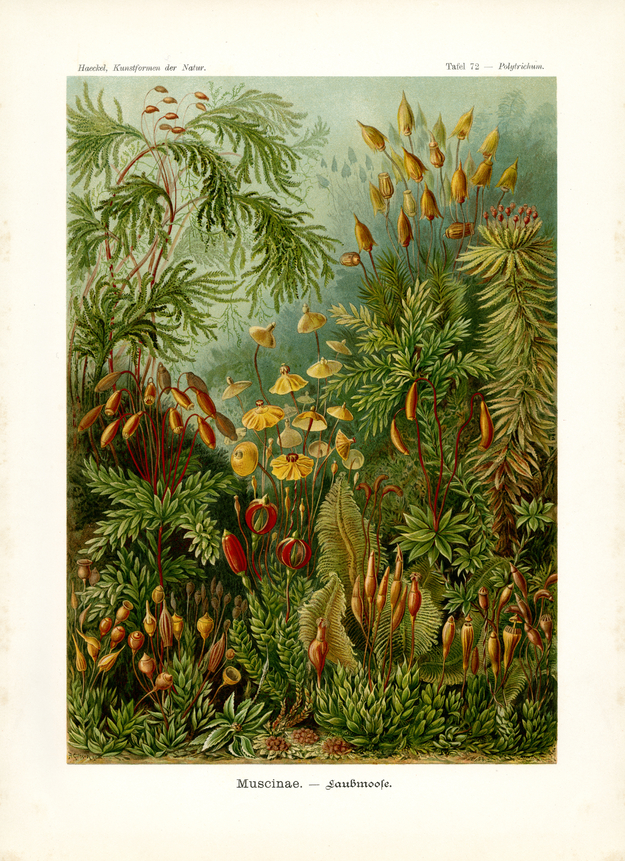Translation of the original German introduction by Ernst Haeckel:
Division of Diaphyta or Archegoniata (Vorkeimpflanyen); - main class of Bryophyta (Moospflanzen); - class of Muscinae (Laubmoose).
As it is generally known mosses are the smallest and most plain among the terrestrial plants; they also show the simplest structure among all Cormophytes or ‘stick-plants’, i.e. those plants whose body is divided into stem and leaf (in contrast to Thallophytes or ‘Thallus-plants’, Algae and Fungi). However, mosses are not only of importance physiologically in the ‘plant life’ of our earth, they are morphologically of great interest in spite of their simple bodily frame. In real mosses (Muscinae) the simple colony or Cormus of the ‘moss-body’ consists of tender, filamentous stalks carrying many leaves and a very small and inconspicuous flower with male organs (Antheridiae) and female organs (Archegoniae). The female gametes contained in the latter are fertilized by flexible sperm cells formed in the Antheridiae and develop into a ‘spore-capsule’ (Sporogonium). This “moss-fruit” or “moss-casket” in most cases looks like a longish-round or bottle-shaped, yellow, red or brown-coloured capsule inside which the asexual gametes or spores evolve. The latter advance from the ripe ‘moss-fruit’ through an opening as soon as the firm capsule wall dehisces, taking the shape of flaps (Andreaea, fig. 12), or of a lid that has been lifted on top (Physcomitrium, fig. 8-10). Usually the spore capsule is covered with a silk- or felt-like cap (Calyptra) that is later cast off (Polytrichum commune, fig. 3, top right).
In terms of beauty of shapes on the whole and of individual parts of the body as well as in the variety of formation the small mosses are in no way inferior to the big statures of the higher ‘plant world’. It, however, requires a magnifying glass – at low magnification (4-8 times) at first – to perceive the “art forms of nature”. Only when using high magnification (200-400 times) the abundance of beautiful motives concealed in these tender plants gets fully revealed. Notably the intricate ‘cell-web’ of the tender leaves offers beautiful motives for embroidery design while the capsule with delicate lid and dentate opening rim provides designs for caskets and bottles.
At low magnification our plate presents the natural colours of a ‘moss forest’ consisting of a number of diverse native moss-species. Such miniature forest is scenically not less beautiful and attractive than a tropical primeval forest composed of a vast number of different tree-species. The tender ranging of diverse colour shades is appealing too, the lighter or darker, in most cases warm or yellowish green of the tender leaflets, the red and brown of the daintily bent stalks, the multiple ranged yellow, red and brown of the delicately formed fruits. At the top left (fig. 1) above the other mosses towers the beautifully contoured Thamnium alopecurum, ‘foxtail-moss’, one of the most impressive tree-shaped moss-species of our native land. Its bold dark-green, richly leaved twigs are entangled with most tender and fine branches of the climbing ‘liana- moss’ (Eurhynchium praelongum, fig. 2). On the right side of it rise high above the strong fruits of ‘grenadier-moss’ (Polytrichum commune, fig. 3) helmet-like covered with a bell-shaped fur cap. To the very right of it, close to the margin, a single stem of ‘peat-moss’ (Sphagnum cymbifolium, fig. 4) is illustrated; its slender, pale, dentate leaves form two regular whorls on top out of which a corona of small, button-shaped, long-stemmed fruits evolve.
The centre of the plate is taken by a group of delicate ‘umbrella-moss’ (Splachnum luteum, fig. 5); its small fruits are distinguished by a very big, umbrella-shaped extension that appears like an opened yellow umbrella. To the left of it (in the centre left, close to the margin) the beautiful palm-like pearlwort (Miniumundulatum, fig. 6) is displayed: out of the centre of a lush, star- shaped rosette of leaves a bunch of nodding fruits with delicately dentate openings rise on slender, red stalks. To the right, three bigger, equally overhanging fruits of the beautiful ‘rose-moss’ (Rhodobryum roseum, fig. 7) are seen: their three long pedicels advance from the centre of a star-shaped rosette of leaves. A number of smaller and lower mosses cover the floor of the moss forest. In the corner left down three species of diminutive ‘bubble-moss’ (Physcomitrium) are presented side by side, to the very left the small caskets of Physcomitrium acuminatum (fig. 8), below the ‘cone-fruits’ with pointed cap of Physcomitrium ericetorum (fig. 9), to the right of it the globose caskets of Physcomitrium sphaericum (fig. 10). At the very bottom (in the centre) three reddish heads of a ‘peat-moss’ (Sphagnummedium, fig. 11) are seen. Four stems of scale-petalled ‘stone-moss’ (Andreaea Thedinii, fig. 12) rise high above them; one out of their three red fruits (to the left) is still closed, the other two dehisced into four flaps. Three broad, triangular plants of the bipinnate ‘fern moss’ (Hypnumeastrense, fig. 13), quite similar to small fern fronds, stand next to them on the right. In the foreground below is a bush of ‘umbrella-moss’ (Tetraplodon urceolatus, fig. 14); finally, in the right corner, there are two species of small ‘double-tooth-moss’ (Dissodon), to the left D. Hornschuchii (fig. 15), next to it D. Frowelichii (fig. 16).
Translation by VR Translators Bangalore
We've scanned the original lithography at 1200dpi on the Epson A3 scanner of A3 scanner huren. You can download a 400dpi JPEG here.
